My new, old apiary
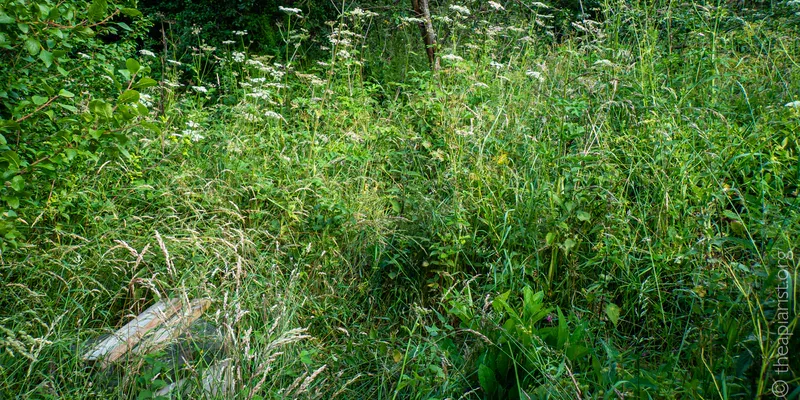
Having relatively recently moved to the Scottish Borders, I'm slowly getting my bees and beekeeping organised. I've not quite started from scratch, but I have increased my colony numbers about 5-fold since the beginning of the season, and hope to generate a few more nucs before this season winds down.
All this has been achieved by sacrificing honey production for bee production, using captured swarms to produce cell raisers, and with three rounds of queen rearing.
It's also been helped by taking advantage of the generosity of beekeeping friends who have offered space in their apiaries while I get established. In exchange, I've donated a few queens, some heavy lifting, dubious advice and bad jokes.
I've lived in Scotland for most of my adult life, but always further North or West than the Borders. It was an area I only vaguely knew, chosen — as only a scientist would — using a Venn diagram of travelling distances to friends and family scattered around other parts of the UK. It sounds both clinical and a bit arbitrary, but it's worked out rather well 😄.

The Borders are windy. At least, the bit I'm in are. Low, rounded hills, wide river valleys, and about 150 metres above sea level.
When it blows — and it often does — it really blows.
Apis mellifera capensis would do well here.
One apiary, well sheltered from cold Easterly and Northerly winds, is really exposed to the South and West. In a blow, I've had frames almost pulled from my hands, or bashed against the side of the brood box, forcing me to abandon hive inspections.
The Lost City of Z
I was therefore delighted to be recently offered space in a very sheltered site, with an acre or two of established fruit trees and good access.
What's more, it's a short distance from home, over three miles from my other apiaries, and 'ticks most of the boxes' in terms of the desirable features I listed in a previous post choosing on apiaries.
Good road access, unlikely to be a frost pocket (based upon the lie of the land, I've yet to see it in winter), promising local forage, reasonable light, level(ish), relatively few local beekeepers, restricted public access, out of sight, and with some expansion and storage space.
Nice 😄.
I'll call this apiary The Lost City of Z (or LCZ for convenience), because it was so overgrown when first viewed that I resembled Colonel P.H. Fawcett bushwhacking my way through the Mato Grosso jungle in Brazil {{1}}.
The Lost City of Z (the original one) was the name given to a city, once occupied by a complex ancient civilisation, that Fawcett believed was somewhere in the Brazilian jungle. Fawcett and his two companions disappeared in 1925 when on an expedition to find the city {{2}}.
Unlike Fawcett, who may have been finished off by cannibals, I managed to escape the jungle of nettles and bindweed … and the natives are very friendly.
Why not sponsor The Apiarist?
Sponsors of The Apiarist receive a newsletter on the science, art, and practice of sustainable beekeeping every week, at least 50% of which are for sponsors only. Sponsorship supports my research and writing and costs about the same as a coffee and doughnut a month, or less annually … go on, you know it makes sense.
My new, old apiary
LCZ isn't virgin territory.
Bees have been kept on the site previously, and as I forced my way through the undergrowth I'd occasionally discover abandoned broods or supers, piles of frames, or tatty split boards.
Signs, like Fawcett expected to discover, of an 'ancient complex civilisation'? … well, perhaps not. I suspect Fawcett was more interested at the prospect of finding gold rather than lost Porter bee escapes and zinc queen excluders.
Aside from the usual 'spares' that can be found littering apiaries the length and breadth of the country, there were also three piles of boxes that — from a distance, and partially obscured by the jungle-like undergrowth — appeared to be hives.
One was easy to reach and contained a mouse, sitting on the open mesh floor surrounded by piles of wax flakes from the wrecked brood frames above.
We were both surprised.
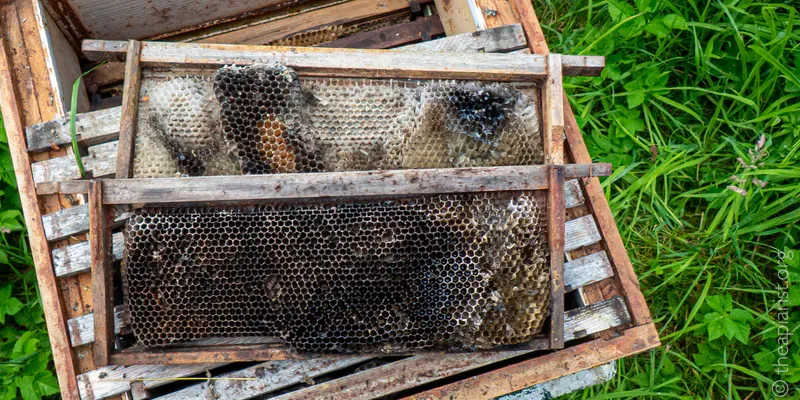
A second had no roof, and the super frames were robbed out and faded by the sun. Everything below the top super looked really messy.
Urgh.
And the third, I'll discuss shortly.
Before I contemplated moving bees to LCZ I needed to hack a route through the undergrowth, clear some space for hives and — as a priority — tidy up and dispose of the old equipment which could otherwise be a source of disease.
Slash and burn
Clearing the undergrowth was the easy bit.
A long, hot morning with my brush cutter — the industrial-strength one requiring a harness, ear defenders, safety specs, full overalls, deeply unfashionable but sensible footwear and lashings of to-and-fro arm swinging — created a path from the car park to the apiary proper.
Where 'car park' means very overgrown area by the gate, and 'apiary proper' means even more overgrown area where further to-and-fro movement proved impossible, the brush cutter repeatedly choked-up and died, and I resorted to a machete.

I've got a couple of Fiskars billhooks from my escapades clearing rhododendron on the West Coast. They have a bit of weight to them, an easy-to-grip handle, and a wickedly sharp blade. The one shown above, which has a slightly more 'hooked' blade, is a much better design that their similar 'brush axe'.
A well aimed swipe with one of these will easily cut through a woody 3–4 cm rhododendron stem, so it made short work of the hogweed, brambles, acres (it felt like) of nettles, and other sappy vegetation that was swamping the site.
That took another morning, uncovered all sorts of aches and twinges in my back, and finally enabled me to see that the site wasn't quite as level as I'd hoped.
Ho-hum. Never mind.
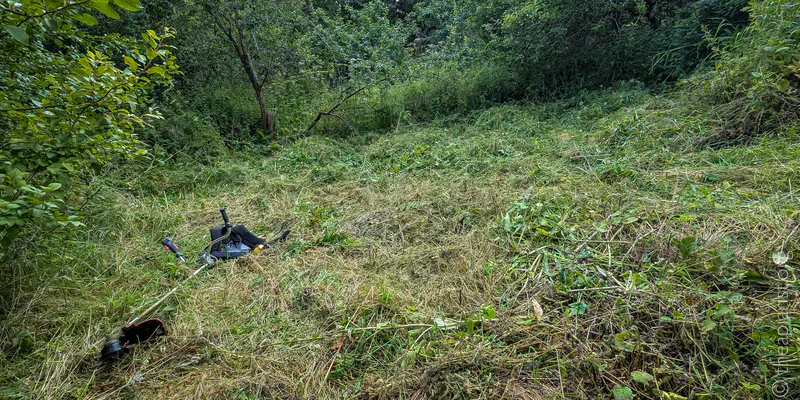
It also created sufficient clear space that I could fire up the brush cutter again for some final tidying. I now need to let the freshly cut vegetation die back a bit, rake it out of the way and decide where to best position the hive stands.
Better safe than sorry
As I made progress through the undergrowth I collected up the various bits of beekeeping equipment; floors, rotted stands, poly bits and bobs, a complete cedar hive (albeit widely scattered), and a large stack of old brood and super frames.
The boxes (with a bit of scorching {{3}}) will be useful for someone in the future, but the frames had to go.

So, I built a fire, and every time I went past — to get fuel for the brush cutter, to fetch the machete, or simply to have a breather and rest my back (mostly this last one) — I'd chuck a few more frames on the pile.
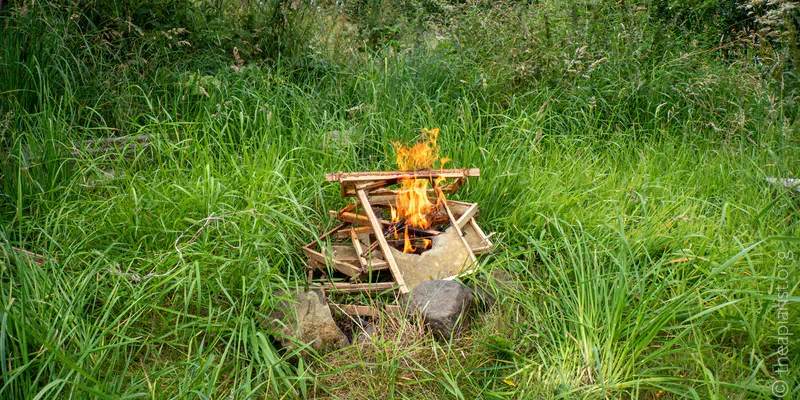
It probably took me a tenth of the time to burn them as it had to build all those frames, but the comb was manky and unusable.
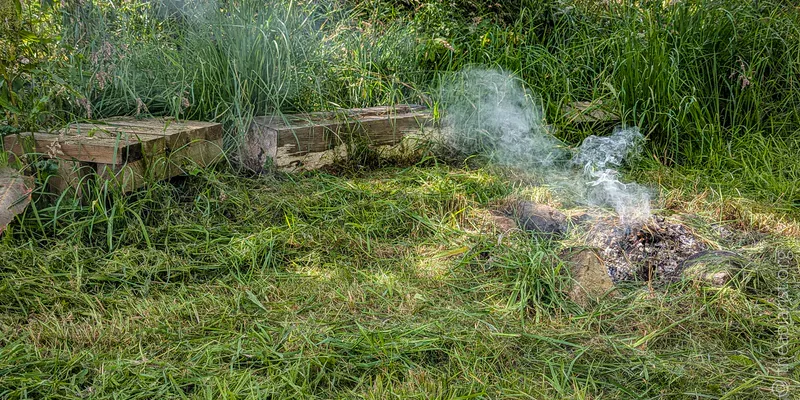
And, it was while I was checking the last of the abandoned boxes that I discovered that the third 'hive' contained bees.
Upper entrance
The hive was actually a couple of empty boxes capped with a crownboard, sat on a paving slab. On top was a thick-walled poly brood box containing about 10 frames and a cedar roof.
The roof was too small to telescope over the brood box, so was just perched on top, leaving a convenient space for the bees to get in and out.
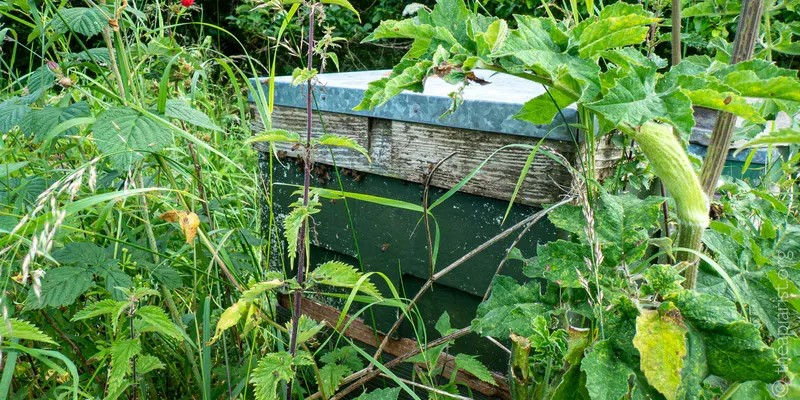
It was obviously a large cast, or a small swarm, that had occupied the box sometime in the last few days. Probably no more than a week ago going by the amount of brace comb they'd built in the roof space. This was a lovely white colour, contrasting starkly with the crumbly, grey, tatty stuff in the frames below.
There was also an empty wasp's nest in the brood box, lots of higgledy-piggledy brace comb, and some very well-tempered bees.
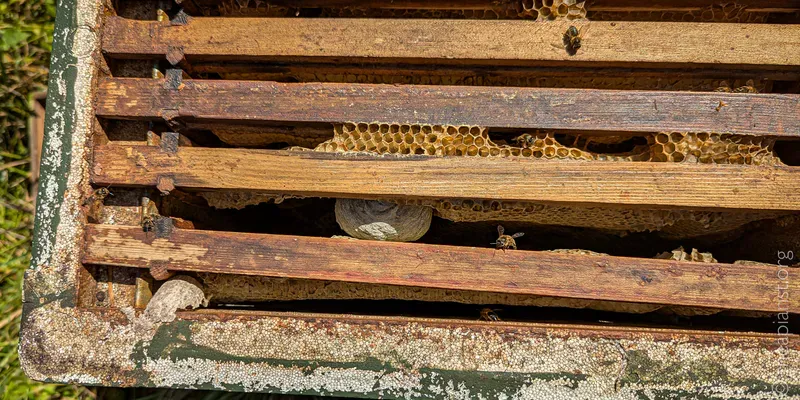
I returned later that afternoon to transfer them into a nuc box.
Concentrate! Stop taking pictures!
When first checking the bees I'd shaken them out of the roof space into the body of the hive, and removed the brace comb. There wasn't enough to justify strapping it into a frame, it contained no brood, and it was so hot that it was very fragile.
I was after the bees, and nothing but the bees.
I moved the brood box aside, confirmed that the remaining stack was stable (and empty of other frames that needed to be burnt), and got ready to place an empty nuc box in its place.
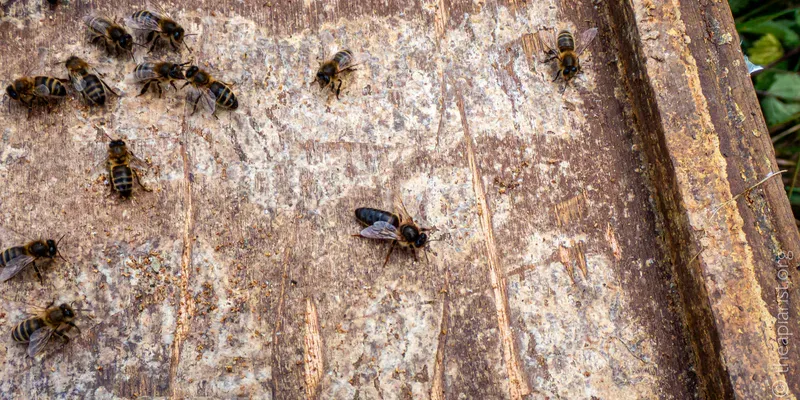
As I moved the crownboard I saw the queen wandering about on the top, together with a couple of dozen bees.
What an opportunity! {{4}}
I had a JzBz queen cage in my pocket and a camera on the ground next to me. I picked up the camera and took a couple of quick photos of the queen {{5}}.
Lovely, it's always nice to get relevant photos to illustrate a post.
Having carefully put the camera down again I fumbled and dropped the queen cage, and — as I stood up again — watched in surprise as the queen took flight.
She flew a couple of quick laps of my Exorcist-like swivelling head before I lost sight of her.
Oops.
Belatedly, I rummaged through the brood box and found no sealed brood and just a very few cells with eggs in them. I suspect the colony had originally been a cast, that the queen was only recently mated, and was still a bit flighty.
The Apiarist, master of the understatement 😉.
These words don't just appear by magic … it takes research, drafts, editing, proofing, and lots of coffee ☕. If you find these posts interesting, useful or informative, but would prefer not to become a sponsor, then please consider maintaining my blood caffeine levels to ensure the next post gets written on time (use this button, or the coffee mug in the corner).
'Stuff' happens
I've had this sort of thing happen before.
If the queen flies off, she usually returns.
You'd think I'd have learned the lesson by now … 😞.
I balanced the nuc box on the crownboard, with the entrance in the approximate location of the original gap under the roof. It looked very different — yellow and blue in comparison to the dark green paint on the poly brood box — but bees are fast learners (clearly faster than me), and they were soon clustering around the nuc entrance.
I shook in the three or four frames of bees from the brood box, piling the unoccupied frames on the 'to burn' stack, and added a feeder and some syrup to encourage them to draw comb.
Despite watching carefully, albeit intermittently, for another hour or so I didn't see the queen return. However, the entrance stayed busy, and there were lots of bees fanning, so I was hopeful she had returned safely.
The Everynuc I used has an open mesh floor, but I'd left the Varroa tray in place to avoid bees clustering on the underside of the box. Whenever I'm shaking bees about like this, or setting up mating nucs, I leave the tray in … queens often end up underneath a hive, and they sometimes get stuck there.
Although the returning queen didn't get trapped under the box (she was still AWOL as far as I knew), a good number of bees ended up there rather than using their smart new yellow entrance.
How ungrateful.
Before leaving the site I smoked the bees gently from underneath the box and stuffed the gaps with some cut grass (of which there was ample to choose from) to encourage them to use the 'front door'.
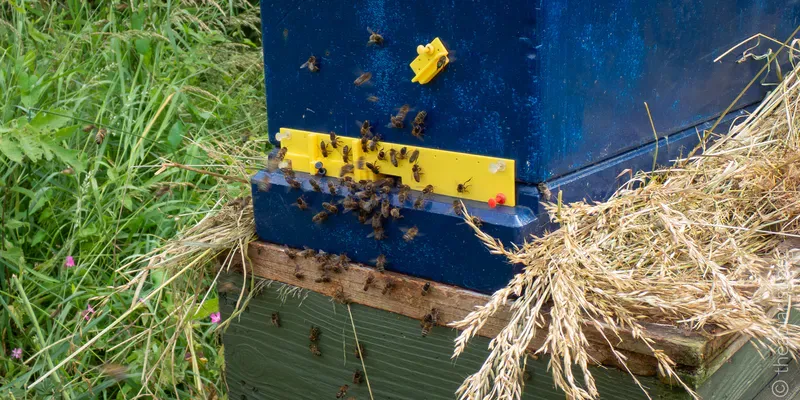
And, the following day, the entrance was busy, there were foragers laden with pollen arriving and if Heinrich Storch — author of 'At the hive entrance' — had been asked, he'd have concluded that the queen was present.
Bees for the LCZ apiary
I rear all my own queens. I'll therefore be populating the LCZ apiary with nucs headed by some of my recently mated queens.
I've done three main rounds of queen rearing this year, using ten grafted larvae each time, and hope to manage one more before the season ends. At my most pessimistic, I expect ~50% success rate — from grafts to mated queens.
There's a lot to go wrong between grafting and a well-mated and laying queen; poor acceptance of the grafted larvae, abandoned or cannibalised during development, failure to emerge, eaten on a mating flight, or simply going AWOL.
If there's a 10% failure rate at each stage then you're quickly reduced to just 4 or 5 mated queens.
However, this year the grafting has gone very well, success I primarily attribute to years of study, weeks of practice, unflinching concentration and (without wanting to sound arrogant) an overabundance of innate ability dumb luck 😉.
The second round of grafting, on the 27th of May, should have resulted in queens emerging on the 8th of June. Disappointingly, 50% failed to emerge {{6}}, leaving me with several queenless 5-frame mating nucs (originally populated on the 6th of June).
I was delayed starting the third round of grafting, but produced another 9 cells which were introduced to hives on the 20th of June (to emerge on the 22nd). Some went into newly set up nucs, others went into the nucs originally primed with the second round cells (those which had failed).
All the queens emerged safely this time and, with some dodgy weather and other commitments, the nucs weren't checked for mated and laying queens until the 8th of July, 16 days after emergence {{7}}.
Laying workers and mated queens
All of these dates are important because I was concerned that some nucs (those set up for the earlier round of grafting) might develop laying workers. I wasn't entirely sure how long it takes for these to develop (and it may well not be invariant), but if they did appear at least I'd be better informed in the future.
When I checked, all the queens I found were mated and laying, none had sealed brood, though most contained 3–4 day old larvae. A couple had laid between 2 and 3 frames up already.
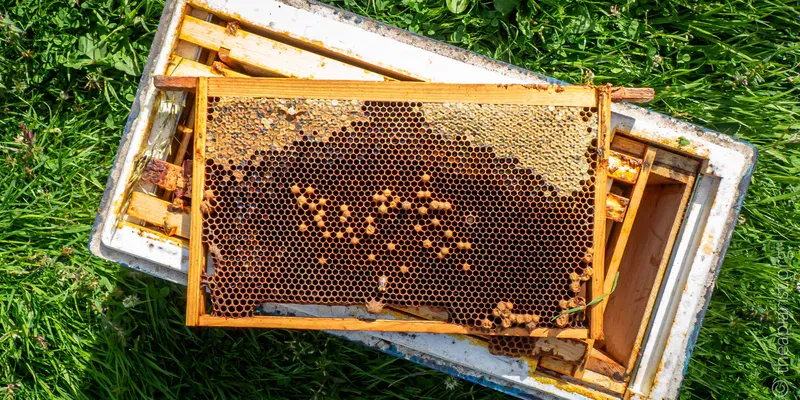
One queen had disappeared, and that colony showed clear evidence of laying workers; bullet-shaped, oversized, drone pupae scattered in worker cells. The frame above contains ~40 of these worker-laid drone pupae, with perhaps the same number developing and yet to be capped. Not a huge number, but quite distinctive. These were present on two or three frames, the others containing stores or fresh nectar.
I shook this colony out, having checked every frame carefully for the queen. My guess is that the workers had killed her, but I didn't want to risk inadvertently establishing another two queen hive 😉.
Notably, one of the nucs containing a mated queen also showed about the same amount of worker-laid drone brood. However, there were also more than two frames filled with eggs … this queen was definitely mated and laying 😄.
Both nucs showing evidence of laying workers were originally made up on the 6th of June.
My interpretation is that there's a 'race', between the laying workers rejecting the queen, and the queen's pheromone levels building up as she starts to lay. In one nuc the laying workers had prevailed, in the other — thankfully — the queen had outpaced them.
Learning from failures
Despite the inevitable disappointment of laying workers, I now have a slightly better idea of how long it takes for them to develop.
The two hives in which they did appear were established on the 6th of June (by splitting up the cell raising colony I'd reared the grafts in). Let's assume that the capped worker-laid drone brood I found on the 8th of July had only recently been sealed, meaning they were from eggs laid no less than 10 days earlier i.e. the 28th of June, 22 days after the nucs were first established.
But, they'd been queenless for a little longer than that.
The cell raiser was put together in very late May, and last contained open brood (which produces the pheromones that suppress ovary activation in workers) on the 1st of June. I'd shaken through the box to find any queen cells on the 2nd, scrutinising every frame carefully, so was certain there was no open brood present then.
So, bees last exposed to open brood at the beginning of June started to exhibit laying worker activity about 4 weeks later (probably 27 days at my best guess).
Four weeks, give or take, is that always the case?
Do laying workers always develop in colonies broodless and queenless for four weeks?
No.
Remember, laying workers are always present at very low levels, but they are inapparent because of worker policing. So, when I say 'develop' I actually mean become visible (and likely become a problem).
I've regularly seen terminally broodless (and queenless) colonies very early in the season, presumably from a queen that failed overwinter.
Although I've seen drone brood from an overwintered failed, drone-laying queen, I don't remember ever seeing the dispersed drone brood created by laying workers at that time of year.
This suggests there might be an environmental contribution — pollen availability, nectar flow, temperature, photoperiod? — involved as well {{8}}.
I need to look into this further, but a cursory search of the literature {{9}} shows a wide range of environmental factors likely contribute to ovary activation (a necessary prerequisite for the development of laying workers).
In addition to brood and queen pheromones, these include nutrition, season and the 'presence and qualities of other workers in the colony'.
Hmm … that last one seems a bit of a 'catch all'.
And, if that wasn't enough, there are genetic factors involved as well. Some strains, or even individual patrilines (workers sired by a particular drone) develop activated ovaries faster.
What have we learnt?
At a first approximation, I'm going to stick with four weeks as the important cutoff.
If you'd asked me about this in March I'd have said 'about four weeks', justifying that with little more than a gut feeling.
Now I've got a small amount of supportive evidence.
This four week window is why I try to check my new queens a fortnight after adding the cell to the mating nuc.
A fortnight if often sufficient time for her to start laying, in which case all is good in the world.
But, if she's missing and/or there are no polished cells or similar signs, and I have mature queen cells or recently emerged virgins spare, I can add one and have another fortnight until I'd expect laying workers to become apparent.
I still have a chance to get a mated queen out of the box.
When queen rearing, the rate-limiting step is frequently the bees used to support the queen when she's mating. These are a valuable resource, and it makes sense to look after them.
Anyway, enough on laying workers … I've got a bunch of nucs with mated queens, and a new apiary to accommodate them 😄.
I now need to spend some time in the Lost City of Z laying slabs for the hive stands … which is where I'm off to now.
Happy beekeeping
More like this?
That's over 3,000 words you've just read on bees and beekeeping. If you want more of this every week, then why not sign up as a sponsor of The Apiarist? At least 50% of posts are now for sponsors only, and sponsors ensure that there will be comprehensive, well researched and entertaining posts on sustainable beekeeping appearing every week.
Notes
- The queen in the LCZ colony got back to the nuc successfully and was laying well when checked the day before this post appeared 😄.
- If you're reading this on a web browser you may recognise the passing reference to another Colonel over the masthead image (Kurtz, in Conrad's Heart of Darkness), this time from the African jungle.
- The few subscribers who have experienced problems signing in over the last fortnight might find the newly-written Accessing restricted content page useful, both as a guide to potential solutions, and as an explanation of what the issue is (TL;DR the company that provides our content delivery network appears to have broken something 😞).
References
Backx, A.G., Guzmán-Novoa, E., and Thompson, G.J. (2012) Factors affecting ovary activation in honey bee workers: a meta-analysis. Insect Soc 59: 381–388 https://doi.org/10.1007/s00040-012-0230-1.
{{1}}: If you'll excuse a metaphor mixing the Amazon and the Antipodes.
{{2}}: And, if you want to read more on this subject, I can thoroughly recommend Peter Fleming's excellent Brazilian Adventure (1933), Fawcett's own — edited by his son — Exploration Fawcett (1953), and David Grann's The Lost City of Z: A Tale of Deadly Obsession in the Amazon (2009).
{{3}}: Other than the poly one, which is a bit of an abomination.
{{4}}: I could pop her in a cage, and she'd be safe while I re-housed the bees. Oh, the irony!
{{5}}: Why? I write a weekly beekeeping blog and like to include suitable photos, that I've taken, to illustrate the articles. I don't want to use the same photos every week, or — surely not? — use generic photos of Langstroth hives on the Midwest prairies, chosen by AI from an image library, and totally unrelated to the subject or the geography 😉.
{{6}}: Jarred transferring them to the incubator? Not sure why this happened, and it's not something I've had occur before.
{{7}}: Typically, I try to check 2 weeks after emergence.
{{8}}: Or I've not looked in enough failed hives early in the season, and laying workers are commonplace. Unlikely.
{{9}}: If you want somewhere to start, try the meta-analysis by Backx et al., 2012.
Join the discussion ...